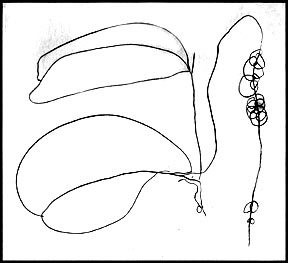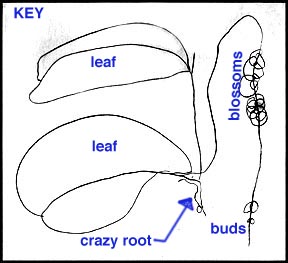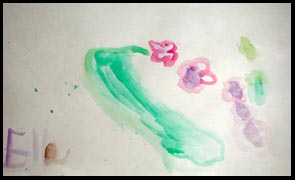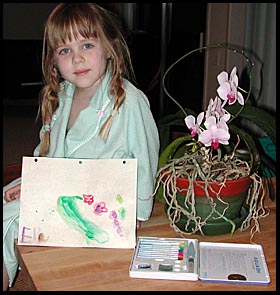|
A story and teaching notes by
Dr. Marvin Bartel, Ed.D.
"How
old
are you?" "Four and three-quarters." Ella like every child
her age was anxious to be five years old.
Ella and Grandpa were sitting together on the floor next to a low
bench. On one end of the bench Grandpa had placed a potted orchid
with seven blossoms. He had brought some paper and a soft lead
drawing pencil. Ella and Grandpa were eating cookies. Ella
had some milk and grandpa had some coffee. They were drinking from cups
Grandpa had made in his pottery shop. Ella liked to sit on the floor.
Grandpa thought it was okay, but it was sort of hard to get up.
Ella's grandfather often thinks about how young children learn.
Thirty years ago he had done his graduate work in art education.
He knew the research, the assumptions about the developmental stages,
and thinking styles of young children. Grandpa knew that many children
become stymied in their drawing ability because adults drew for them
rather than helping them learn to draw. Few adults understand how
to teach drawing to a young child.
Grandpa knew that young children draw without any instruction.
But, he also knew that many young children had become uninterested in
drawing or afraid to draw because "helpful" adults had discouraged
their natural inclinations to draw and learn from the practice.
Adults often draw for children and expect the children to imitate their
drawings. This seldom works. Young children make very inferior
copies. Both the child and adult give up in frustration. They excuse
themselves - assuming that drawing is a talent rather than a way of
thinking and seeing that is developed through practice.Well
meaning adults who expect imitation are expecting exactly the wrong
thing. The right thing is for the child to attend to her/his own
experience with the thing being drawn. Learning to attend to an adult's
drawing distracts from the learning task and produces dependency and
limits brain development. Drawing
is not an innate talent - it is a skill of the brain that is nurtured
through practice in attending to the thing being drawn - not an adult's
drawing of it.
Art educators find that most children
stop drawing entirely as they reach age eight or ten. By this age
they have become aware of how "stupid" and "childish" their drawings
look. These
"baby talk" drawings are too embarrassing. Grandpa thinks that if
we taught reading and writing as poorly as we teach drawing, about 10
or 20 percent the adult population would be literate.
Grandpa shares this story as insight
into how we need to change the way drawing is taught to
children. Please continue reading.
"I'm
glad you helped Grandma make these cookies. Aren't they good?"
"Yes!" Ella replied.
Grandpa
continued, "This is really
a beautiful orchid. I noticed yesterday that you were giving it some
water. How long have you had this orchid?" "Since I was born." Ella replied. "Wow, that's
amazing. When I get an orchid, it blooms for a few months, then
the leaves start to get yellow and pretty soon we just have to toss it
out."
"Who
takes care of this orchid to keep it so nice?" "Just me. I water it." Ella replied.
"Do you water it every day?" "No." "How do you know
when to water it?" "When the dirt feels dry." "Well, the orchid must
really like it. It sure has lots of flowers." "How many flowers
does it have?" Ella begins
pointing to each flower while saying
the numbers from one to seven. Grandpa exclaims, "Wow,
seven
blossoms!"
Grandpa
continued to talk about the orchid to get Ella to see more parts of
it. "Did you notice these silly roots? This orchid
has a
whole bunch of roots that are up in air. I thought just the
branches and leaves were supposed to be in the air. Why do you
think it has roots in the air?" "I don't know" Ella responds. Grandpa says,
"I don't know either, but I think the roots really
look
sort of funny."
Grandpa
continues, "Shall we see if you can draw a picture of just one
these
roots. You pick one of the roots that you like and I will teach
you how you can learn to draw it. Which root looks interesting or
silly to you." Ella points to
a root that is about 5 inches long
that arches up from the plant and then goes horizontally for two inches
and dips down again.
Ella
is anxious to start drawing and picks up her pencil. Grandpa
says, "Just a minute, I want to look at this silly root before
you draw
it. Watch my finger how it slides along the top of the root
slowly from one end to the other. Could you slide your finger
along the root and see how the line first sort of slants up. Then
which way does it go?" Ella
says, "It turns a little and still
goes up." "That's
right!" says Grandpa.
"Then which way does it go?" Ella
says,
"Then it tips a little bit." "Okay! That's right"
responds Grandpa.
Next
grandpa says, "Now I will go back a little ways and just point
to
the
root with my pencil, but I am too far away to actually touch the
root. Now watch me move the pencil in the air while I pretend to
slowly
draw the root in the air." Ella
watches. Grandpa says, "Now
you can slowly draw with your pencil in the air to practice making the
shape of the root." Ella
practices it by pointing her pencil to
the root and draws it in the air. Grandpa watches and says,
"That was good! Now practice it in air one more time, but this
time do it
really slowly so your pencil can follow the shape easier." Ella practices
again. Grandpa says, "I bet you could show me on the paper
how
root is shaped. Where do think the root should start so it fits
on the paper? Ella points out a spot on the paper and
Grandpa says, Good,
now you can draw it on the paper. While
you are drawing, you can stop and practice in the air anytime you are
wondering how to draw the next thing. Just stop drawing and look
back at the orchid and it will show you how it looks."
Ella,
age four and three quarters, proceeds to draw the root, the leaves,
the sweeping blossom stock and the 7 orchids and buds more or less from
observation. Grandpa sits in amazement and wonders if he will be able
to get up from the floor.

Ella's pencil
drawing of an orchid.
The original is
about 8 inches
wide.
Click here for her watercolor painting of the same plant.

Sequence: The
single root was first. Then the
bottom leaf and the top leaf. Thirdly, she added the blossom stem. The
blossoms and the buds were last. When you watch children draw flowers,
what do they draw first? How much to they add?
Postscript
Why do you think I zeroed in on the silly root rather than the orchid
flower? I assume that every child's brain already has a picture of a
flower ready to draw. This is an obstacle when teaching perception. The
part of our brain that learns how to make careful observations does not
develop if draw from what our brain thinks
that it already knows about how things look. New observations are
blocked or overlooked because of
these preconceptions. I look for subject matter that the brain has not
yet stereotyped and cataloged. Therefore, I often select the mundane,
the trivial, the little details, from the child's ordinary experiences.
When I talk about this to adults, I say that in order to learn to draw
we have to see the world without prejudice - as God sees.
PRINCIPLES
TO
SELECT SUBJECTS
When teaching perception, it easier if we select subjects that are new
and unfamiliar
(not yet learned). That is why the root and not the flower was used. A
familiar thing like a well loved toy animal can be made to look
unfamiliar by turning it upside down, backwards, etc.
When teaching
perception it is important to select something that is easy enough
to avoid frustration. That is why only one root was selected in this
story. Had Ella stopped after the one root, that would
have been fine.
It must be challenging
enough require some detailed study and concentrated practice in the air.
Using both touch
and vision is more perceptual than using only vision. That is why a
simple square thing, or a simple round thing like a ball, is not very
useful.
The thing observed has to be unexpected
enough in some way so that careful looking is required. Avoid
things for which the
child's brain has already created and stored a stereotyped image.
When teaching perception it is
helpful to select subjects that are emotionally important to the person
doing the drawing.
SHARING
SECRETS
When I teach I ask children if they can guess why I picked the subject
that
was picked. I explain the above principles to children so they can use
the principles themselves when they practice.
--see more below
|
|
How
to Draw
A
Poem
by
David
Wright
First,
grow
one;
fuss
with the soil;
search
for ample light.
Recall
the one
you
watered to death.
Learn
the name
of
the crazy roots,
(besides
crazy roots).
Trace
a single rhizome
from
node to soil.
Then
again. Again.
With
index finger,
sketch
it in the air.
Forget
Van Gogh.
Ignore
O’ Keefe.
This
is your flower,
its
curve, its day
to
bloom. Find
the
color then
close
your eyes
Wait
long enough.
You’ll know. Then,
you’ll
start to draw.
David Wright
© 2003
|
|

back to top of page ^

back
to top of page ^
Teaching
Notes
As the teacher, I did no drawing
in this drawing lesson. I draw the line on this. When the teacher
begins to draw, the child will stop looking at the real source and
begin looking at the adults replica of the source. This is not
learning to see. This develops a common problem among children.
We call it learned helplessness.
Ella
had no chance to copy my drawing. Ella had to get her visual data
from the orchid root itself. She was learning to be
self-sufficient - not dependent and helpless.
I showed observation methods. I never corrected Ella and took every
opportunity to affirm and encourage her efforts. Young children
respond positively to positive motivation. Negative motivation
may work to stop something, but it does not work to promote something
positive.
In subsequent lessons I have shown Ella how to use a "blinder" on her
pencil. A blinder
is an 8 x 8 inch piece of heavy paper with a small hole in the
middle. Her pencil is placed in the hole. The blinder hides
her paper while she draws a new thing. This keeps her eyes on the
subject instead of the paper. At age six when Ella wants to draw
a new thing she puts the blinder on her pencil and makes practice
drawings on her paper. Often this ends up to be a jumble of
lines, but the individual lines are amazingly faithful to their
sources. After this "seeing practice" she takes the blinder off
her pencil and makes another drawing while looking at her paper and at
the subject.
At age six, Ella
reads well and enjoys leaning to add two digit numbers.
Teachers are good at teaching reading, writing, math, and so on.
However, most children have no art teachers that bother to teach them
art. Too often their art is mainly offered as relaxation. Some
teachers give them busywork projects. The busywork is made up of
prescribed pictures, tracing, or craft projects that are largely pre
designed. Other teachers simply allow them play around and do
whatever they wish. If I were to choose, I would rather see the
'play around' method than the 'cute craft project' busywork. While
these activities are not immediately harmful, they do leave a gap in
their education and mental development.
In many schools art is taught so poorly in the younger years that most
children feel totally incompetent by the time they reach grade
three. Only the few who have practiced more excel. Often
the 'talented' ones have parents who are particularly generous with
materials and encouragement. These children are called the
'talented artists' in the class. The remainder of the class
suffer from what is called a "crisis of confidence". They stop
practicing because nobody ever helped them learn how to trust their own
perception and practice productively.
Schools in Japan are faulted by some because their culture honors the
group more than we do at the expense of the individual. Children
that are particularly gifted and creative are discouraged from being
different. "If the nail sticks out, hit it down." is a common saying.
This has both positive and negative educational and societal
outcomes. While individual creativity may suffer, the ability to
create and produce high quality in groups may be stronger.
Japanese schools include regular observation drawing along with work
from memory and imagination in the early school years. Young
children can often be seen in the school flower garden making
observation watercolor paintings or out in a plaza painting a fire
truck that is placed for their observation. They all learn to
draw as an expected part of the curriculum. While we tend to give
about an hour per week to art instruction, they are apt to allow about
three hours per week in the early grades. They develop extended
attention spans and the ability to focus on a task that serves them
well in other learning as well. -- more below
back to top
of page ^
|
|

On
the following day after Ella did the pencil drawing at four and
three-quarters, feeling confident in her ability and self-sufficient,
Ella decided that she would try out a set of watercolors that her great
grandmother, age 94, brought her from Japan.
|

back to
top of page ^
|
SHOULD ALL THEIR DRAWING BE FROM OBSERVATION?
No. In addition to direct observations, other
good sources of content for children's drawings include, their imaginations
(another important area of brain development), their everyday experiences,
their memories, and special events (both good and
bad) in their lives (important for emotional development). We
motivate children to elaborate more more in their drawings by asking
them open questions that bring to mind ideas from their own experiences
- not by drawing for them. We
give positive feedback about their work. We provide unlimited paper or
a white board (with non-toxic markers). We treat the artwork as a gift
no matter how it looks. When we fail to understand we do not say,
"What is it?" We say, "Can you tell me more about this?" Young children
are not corrected in their drawing. If young children are corrected in
their drawing, they will automatically move to a less beneficial
activity such as watching cartoons on TV, or some other brain shrinking
activity.
Similarly
beneficial
activities include playing with simple blocks, Legos
(without patterns to follow), clay, Play-Doh, and so on. Blank
paper is better than coloring books (even coloring books can promote
learned helplessness). Coloring you own picture is better.
Drawing your own maze is better than doing somebody else's maze in an
activity book
Marvin Bartel Home Page
Goshen College Art Department
Goshen College
All
rights reserved. Photographs,
text, and design © Marvin Bartel and bartelart.com.
How
to Draw and Orchid (poem) is © David Wright
2003. Ella's work is
her property and may not be published without permission from her
parents.
Parents,
care-givers, pre-school teachers, and art
teachers may make one copy for personal study. Permission
is required to make any other copies, to publish, or to post on another
web site.
Please mention the URL or
the
title of this page in your correspondence with the author.
You may make a
link to this page from your page without permission, but you may
not
post this page or any photos from this page on another web
page without permission. Your
correspondence, experiences, ideas, and questions are welcome.
|



